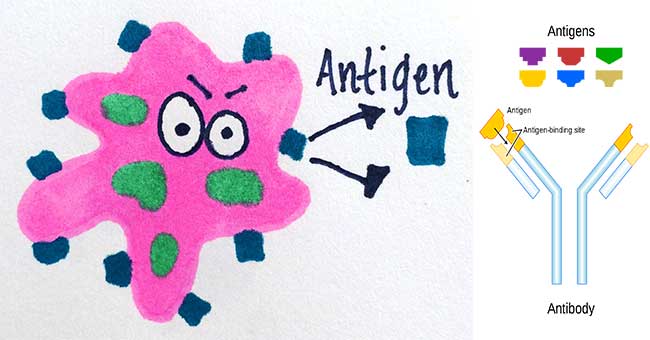Interesting Science Videos
On basis of Source/Origin
- Exogenous antigens: These are antigens which are foreign to host body hence are also called foreign antigens. These are antigens that enters the body of the organism from the outside, e.g. through inhalation, ingestion, or injection. These antigens enters the body or system and start circulating in the body fluids and trapped by the APCs (Antigen processing cells such as macrophages, dendritic cells etc.). The uptakes of these exogenous antigens by APCs are mainly mediated by the phagocytosis. E.g. Bacteria, Fungi, Viruses etc.
- Endogenous antigens: These are antigens which originate from own body of host organisms. These are body’s own cells or sub fragments or compounds or the antigenic products that are produced. The endogenous antigens are processed by the macrophages which are later accepted by the cytotoxic T – cells. E.g. Blood group antigens, HLA (Histocompatibility Leukocyte antigens) etc. Endogenous antigensare generated within normal cells as a result of normal cell metabolism, or because of viral or intracellular bacterial infection.
- Auto antigens: These are usually a normal protein or protein complex (and sometimes DNA or RNA) that is recognized by the immune system of patients suffering from a specific autoimmune disease. These are not immunogenic under normal condition however due to genetic and environmental changes or factors immunological tolerance is lost and immune response is generated. E.g. Nucleoproteins, Nucleic acids, etc.
Some antigens can be exogenous in origin but later can turn endogenous. E.g. Intracellular viruses.

On the basis of immune response
- Immunogens/ Complete antigens: A substance that induces specific immune response can be called as immunogen. Antigens which are able to generate immune response by themselves are known as complete antigens. These are generally molecules with high molecular weight (more than 10,000 Daltons). They possess antigenic properties denovo and are usually proteinaceous in nature. Some of them can be polysaccharide in chemical nature.
- Haptens/ Incomplete antigens: Antigens which are unable to generate the immune response themselves are termed as incomplete antigens however on coupling with carrier proteins they can be immunogenic. They are also called haptens. When a molecule of haptens are coupled to carrier proteins they become accessible to immune system and function as an immunogen. They generally have low molecular weight (Less than 10,000 Daltons) and are usually non-protein substances. E.g. Capsular polysaccharide of pneumococcus, polysaccharide “C” of β-haemolytic streptococci, Cardiolipin antigens, etc.
Carrier molecule is a non-antigenic component and helps in provoking the immune response. Example: Serum Protein such as Albumin or Globulin
Superantigens
Superantigens (SAgs) are a class of antigens that cause non-specific activation of T-cells resulting in polyclonal T cell activation and massive cytokine release. SAgs are produced by some pathogenic viruses and bacteria most likely as a defense mechanism against the immune system.
Superantigens are a class of molecules that can interact with APCs and T lymphocytes in a nonspecific way. The superantigens act differently by interacting with MHC class II molecules of the APC and the Vb domain of the T-lymphocyte receptor. This interaction results in the activation of a larger number of T cells (10%) than conventional antigens (1%), leading to massive cytokine expression and immunomodulation.
When the immune system encounters a conventional T-dependent antigen, only a small fraction (1 in 104 -105) of the T cell population is able to recognize the antigen and become activated (monoclonal/oligoclonal response). However, there are some antigens which polyclonally activate a large fraction of the T cells (up to 25%). These antigens are called superantigens.
Examples of superantigens include: Staphylococcal enterotoxins (food poisoning), Staphylococcal toxic shock toxin (toxic shock syndrome), Staphylococcal exfoliating toxins (scalded skin syndrome) and Streptococcal pyrogenic exotoxins (shock).
The diseases associated with exposure to superantigens are, in part, due to hyper activation of the immune system and subsequent release of biologically active cytokines by activated T cells.
Autoantigens: These are antigens despite being a normal tissue constituent, is the target of a humoral or cell-mediated immune response, such as in autoimmune disease. E.g. Thyroglobulin, DNA, Corneal tissue, etc.
Alloantigens: These are antigens found in different members of the same species. E.g. Red blood cell antigens A and B.
Heterophile antigens: These are same or closely related antigens, sometimes present in tissues of different biological species, classes, or kingdoms. identical antigens found in the cells of different species. Examples: Forrssman antigen, Cross-reacting microbial antigens, etc.
